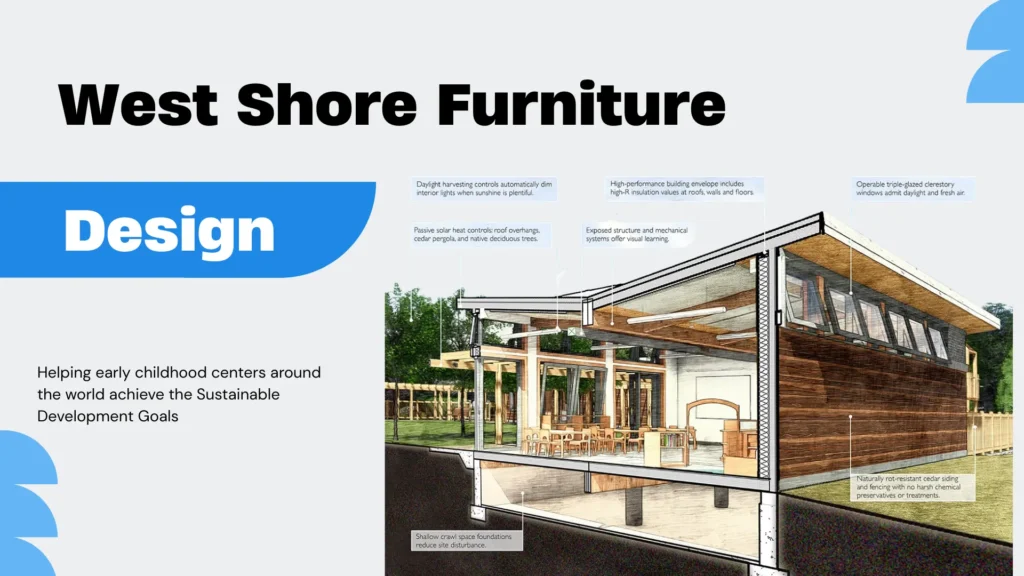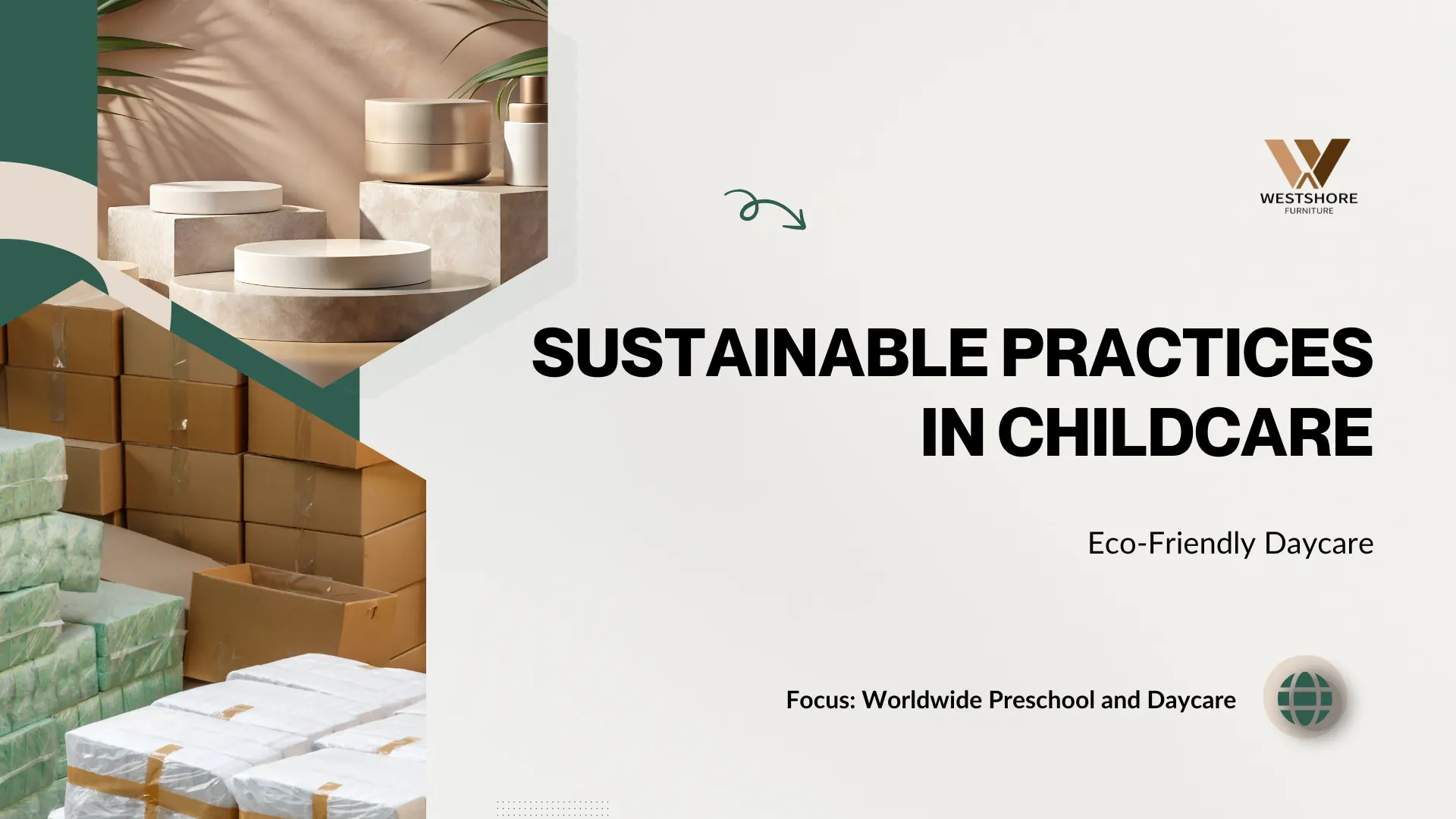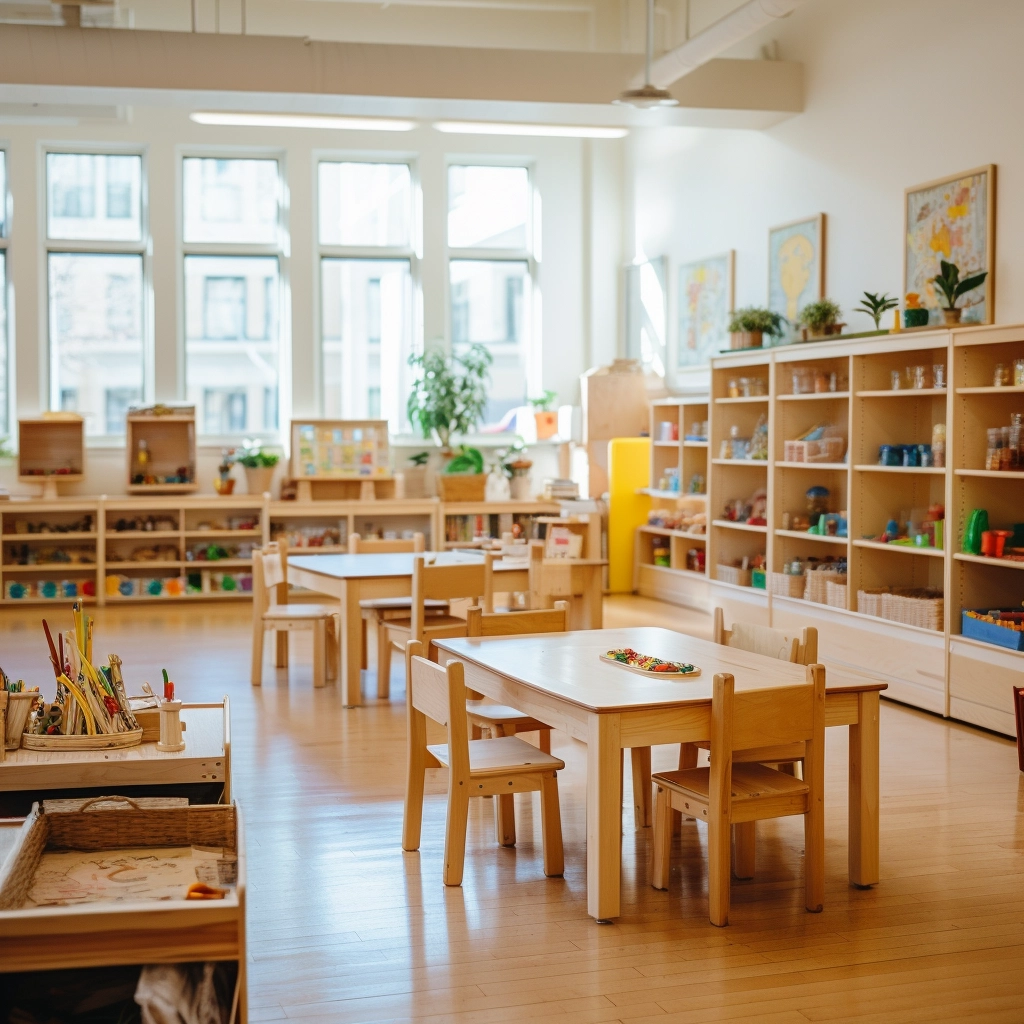Imagine a classroom where the tables are made from natural wood, where recycled paper becomes tomorrow’s art project, and where rainwater collected outside is used to water a vegetable patch that the children planted themselves. This is not a dream. It is what sustainable practices in childcare look like in action.
In today’s world, sustainability is no longer just a trend. It is a necessity. And there is no place where it matters more than in the environments where our children grow, learn, and form lifelong habits. As early childhood educators, parents, and childcare providers, we have both the power and the responsibility to create spaces that teach not only the ABCs but also care, awareness, and a deep connection to the earth.
Integrating sustainable practices in childcare brings benefits not only to the planet but also to the health, development, and emotional well-being of children. Research consistently shows that natural environments reduce stress, enhance cognitive growth, and support the development of empathy and social responsibility. More importantly, children can understand and internalize sustainability when these practices are woven into their daily routines. This can include activities such as sorting recyclables, conserving water, and learning to use energy responsibly.
In this guide, I will share practical and achievable sustainable practices in childcare that you can apply in every part of your daycare. From selecting safe, natural materials to introducing hands-on environmental programs, we will explore how to transform your childcare environment into a living, breathing example of sustainability. By doing so, you help raise a generation of children who value nature, care for their surroundings, and grow up with an instinctive respect for the planet.
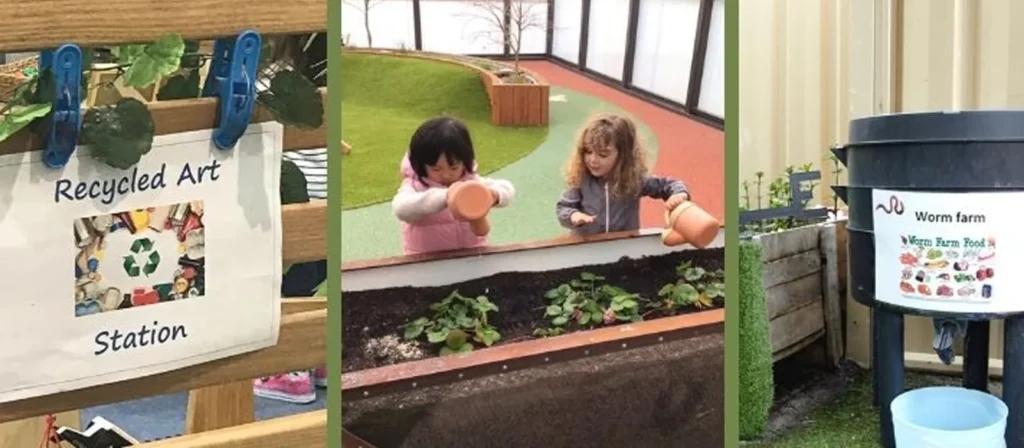
What is Sustainability?
Sustainability means making smart, responsible choices about how we use resources today so we don’t take away the chances for future generations to enjoy those same resources. In childcare, sustainability is not just a concept; it is a practical approach to education, environment, and daily operations.
Sustainability involves making conscious decisions that reduce environmental impact while ensuring social and economic well-being. It includes practices such as conserving energy, minimizing waste, and choosing materials and processes that do not deplete natural ecosystems.
In early childhood settings, sustainability is about more than just recycling. It includes creating safe, natural spaces, encouraging environmental responsibility, and fostering a culture of care and awareness. By modeling environmentally responsible behavior, educators help children develop a sense of responsibility toward the planet.
The Importance of Sustainable Practices in Early Childhood Education
Sustainable practices in childcare are not just beneficial for the planet; they are essential for shaping responsible, thoughtful, and capable future citizens. By introducing these values early, we give children the tools to grow with care, empathy, and awareness.
Developing Lifelong Habits
The early years are the best time to form habits, and children quickly learn through observation and action. When an eco-friendly daycare integrates sustainable practices in childcare into routines such as turning off lights, using reusable containers, or recycling, these behaviors become second nature. Small daily actions lay the foundation for eco-conscious choices that children are likely to carry into adulthood, showing them that even simple steps can make a meaningful difference.
Promoting Holistic Development
Sustainability supports not only the planet but also children’s overall growth. Activities such as caring for a classroom garden build teamwork and communication skills, while reusing materials for crafts develops creativity and problem-solving. A daycare with a healthy environment, filled with plants, natural toys, and safe materials, helps reduce stress and improve focus. These sustainable practices in childcare nurture empathy, patience, and responsibility, essential qualities for lifelong development.
Building a Sustainable Future
Introducing sustainability early helps children connect values with action. Through hands-on sustainability activities for childcare, such as composting, gardening, or energy-saving routines, children develop respect for the environment and a sense of responsibility for the future. In this way, an eco-friendly daycare becomes more than a place of learning; it becomes a living model of how to create a better and more sustainable world.
With a clear understanding of why sustainability matters in early childhood education, the next step is to bring it into practice. In the following section, we’ll look at how to start integrating sustainability into daycare centers in ways that are both meaningful and manageable.
Möchten Sie einen Raum gestalten, der zum Lernen anregt? Kontaktieren Sie uns, um individuelle Möbellösungen zu entwickeln, die auf die Bedürfnisse Ihres Klassenzimmers zugeschnitten sind.
Integrating Sustainability into Daycare Centers
Sustainability in childcare should not be treated as an isolated activity or one-time initiative. It needs to be embedded into the daily operation, physical environment, and safety policies of daycare centers. This section outlines how sustainable practices can be systematically applied across three key areas: operational routines, environmental design, and child health and safety.
Sustainable Practices in Childcare
Sustainability begins with the choices we make every day. Many of these choices are hidden in the daily operations of a childcare center: what materials we use, how we handle waste, how much water or electricity we consume, and how we clean our spaces. Each of these details offers an opportunity to model environmental responsibility and reduce our ecological footprint. That’s why integrating sustainable practices in childcare is not just about policy—it’s about everyday action.
Sustainable practices in childcare are not an isolated topic; they form a core operational responsibility. According to Australia’s National Quality Standard (NQS), specifically Standard 3.2.3, early learning services must care for the environment and support children to become environmentally responsible. Similar expectations are embedded in global frameworks such as the EU Eco-Schools program and LEED certification in North America.
To meet these standards, childcare centers must ensure that sustainable practices in childcare are embedded into day-to-day operations, not added on as an afterthought. This means making consistent, intentional decisions that reduce environmental impact while protecting children’s health and promoting lifelong environmental awareness.
Reduce Waste
Waste reduction is one of the most achievable and visible forms of sustainable practices in childcare. Most waste in early childhood services comes from single-use items: paper towels, food packaging, diapers, plastic cutlery, and broken plastic toys.
Practical strategies include:
- Conducting a waste audit every quarter to identify the main sources of waste
- Replacing paper towels with cloth alternatives that can be washed and reused
- Introducing reusable nappies or eco-diaper programs where appropriate
- Encouraging waste-free lunches with reusable containers
- Setting up color-coded bins for recycling, compost, and landfill, using child-friendly visuals to help children participate
According to the NQS, children should be actively involved in sustainable practices in childcare. That means waste sorting isn’t just for staff—it’s part of the educational experience. When children help compost fruit scraps or reuse boxes for art projects, they learn by doing.
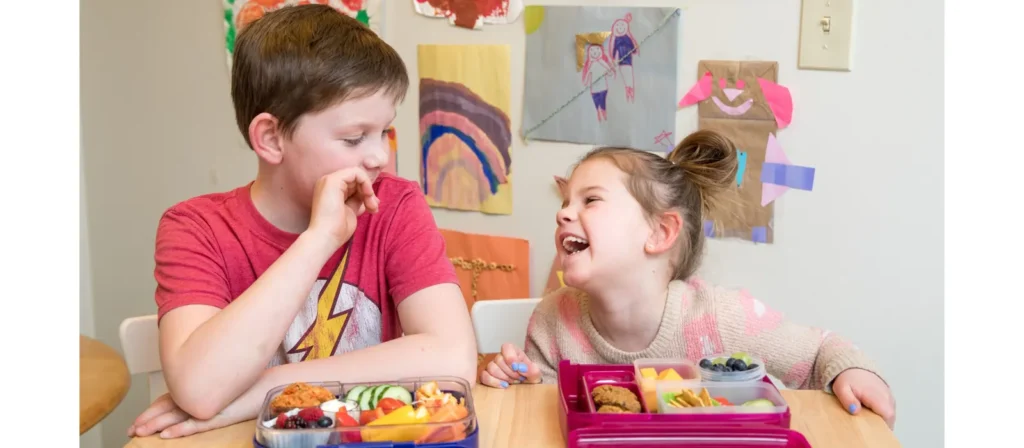
Reduce Energy and Water Consumption
Efficient use of energy and water is not just environmentally responsible; it directly supports regulatory compliance and reduces operating costs. Embracing these actions contributes to the implementation of sustainable practices in childcare, helping services become greener and more efficient.
Actionable practices include:
- Installing LED lighting and motion sensors in classrooms and hallways
- Using natural light wherever possible during daytime operations
- Introducing time-controlled watering systems for outdoor gardens
- Installing dual-flush toilets and low-flow taps in child-accessible bathrooms
- Educating staff and children to switch off lights, devices, and taps when not in use
These measures align with international green certification criteria and NQS expectations, which emphasize the ongoing improvement of environmental practices within services. In countries like Germany and Sweden, similar sustainable practices in childcare are not only common—they’re considered best practice.
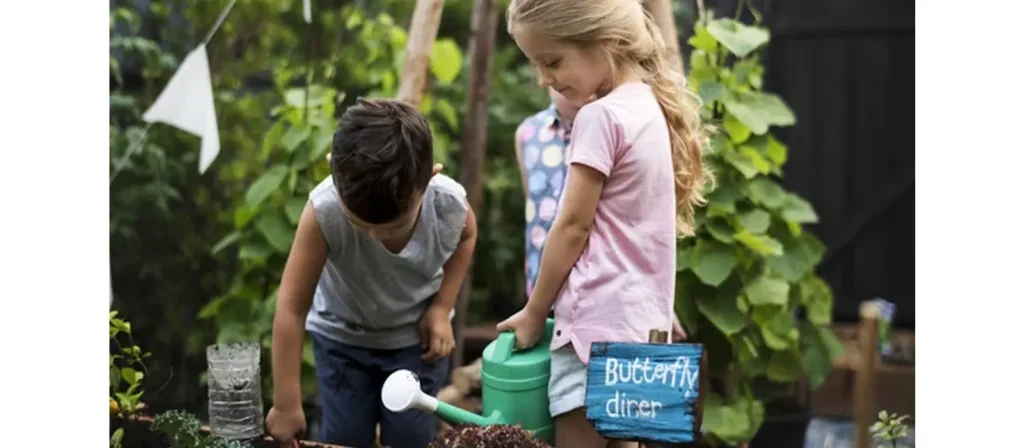
Minimize Exposure to Harmful Substances
Young children are more vulnerable to environmental toxins due to their developing immune systems and increased sensitivity to chemical exposure. Many commonly used products in childcare centers, including cleaning agents, paint, furniture, and even toys, contain volatile organic compounds (VOCs) and other harmful substances. Implementing sustainable practices in childcare includes minimizing these risks as a priority.
To create a low-tox, child-safe environment:
- Use certified low-VOC paints, adhesives, and finishes (e.g., West Shore Furniture)
- Choose furniture made from natural, untreated, or sustainably sourced wood
- Replace PVC-based flooring and wall coverings with natural alternatives like bamboo, cork, or linoleum
- Switch to eco-certified cleaning products that are biodegradable and fragrance-free
- Regularly air out indoor spaces and maintain healthy ventilation systems
- Train staff to recognize greenwashing and select genuinely eco-safe materials
In some countries, like Denmark and the Netherlands, daycare licensing authorities require low-emission materials. While not always legally mandated in every country, adopting these sustainable practices in childcare demonstrates a strong commitment to child health and ecological stewardship.
Möchten Sie einen Raum gestalten, der zum Lernen anregt? Kontaktieren Sie uns, um individuelle Möbellösungen zu entwickeln, die auf die Bedürfnisse Ihres Klassenzimmers zugeschnitten sind.
Creating an Eco-Friendly Environment
An eco-friendly daycare environment goes beyond energy-saving appliances or compost bins. It’s about creating a sensory-rich, natural atmosphere where children feel connected to the environment around them. From the classroom layout to the outdoor spaces, every design choice has the potential to reinforce the principles of sustainability.
Use Natural Materials in the Environment
Natural materials like wood, wool, cotton, and stone do more than provide aesthetic value. They reduce exposure to synthetic chemicals and plastics while engaging children’s senses. Incorporating items like wooden tables, bamboo baskets, and linen fabrics brings warmth and authenticity to learning spaces. These design elements promote comfort, creativity, and curiosity. More importantly, they open conversations about material origins, sustainability, and responsible consumption. By using such elements, educators naturally introduce sustainable practices in childcare through daily interactions. Children start asking where things come from and why they matter, which encourages critical thinking and environmental responsibility.
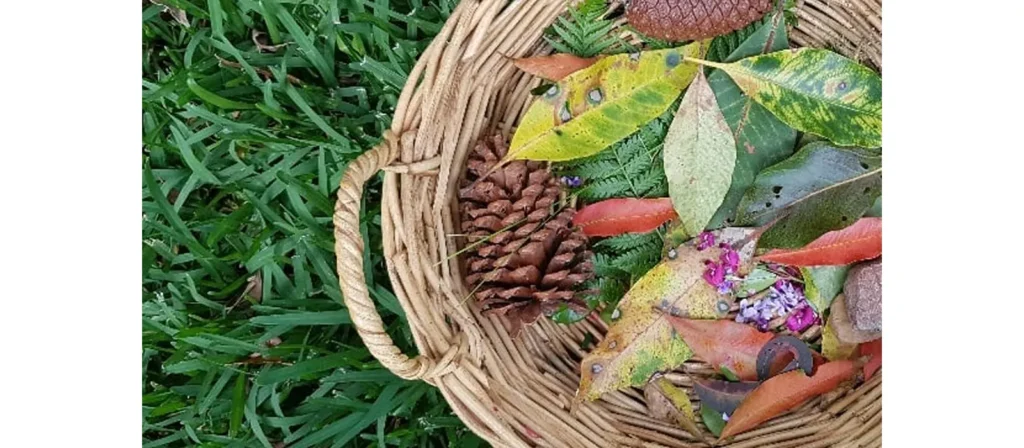
Reuse and Upcycle to Promote Sustainable Development
Reusing and upcycling resources is one of the most accessible and creative ways to implement sustainable practices in childcare. Instead of discarding worn furniture or empty containers, these items can be repurposed into valuable learning tools or imaginative play resources. For example, jars can become flowerpots, and cardboard boxes can be transformed into puppet theaters or building blocks. Educators can integrate these practices into the curriculum through art and construction activities that use recycled materials. This approach encourages children to see potential in everything around them and fosters problem-solving skills while reducing environmental waste.
Improve Indoor Air Quality
Clean indoor air is essential for children’s health and well-being, and it plays a key role in implementing sustainable practices in childcare. Poor air quality can negatively impact concentration, behavior, and respiratory health. To improve it, centers should prioritize natural ventilation, limit synthetic furnishings, and introduce air-purifying plants such as snake plants and spider plants. Avoiding wall-to-wall carpeting and using non-toxic materials also helps reduce allergens. Regular maintenance of HVAC systems and the use of HEPA filters can further enhance air quality. These steps not only support physical health but also demonstrate a proactive, sustainable approach to indoor care.
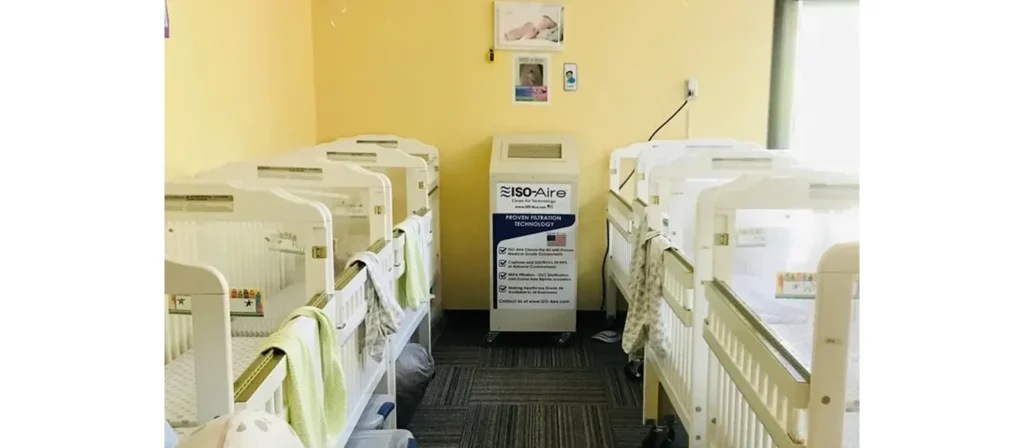
Adopt Green Cleaning Solutions
Traditional cleaning products often contain harsh chemicals that are harmful to both children and the environment. Shifting to plant-based, biodegradable alternatives is a simple but powerful way to implement sustainable practices in childcare. Using green cleaning products reduces toxic exposure and protects waterways when waste is rinsed away. Staff training is essential to ensure proper product use and dilution to minimize waste. Switching to reusable microfiber cloths also cuts down on single-use wipes. These practices create safer spaces while modeling eco-conscious behavior for children and reinforcing the idea that cleanliness and sustainability can go hand in hand.
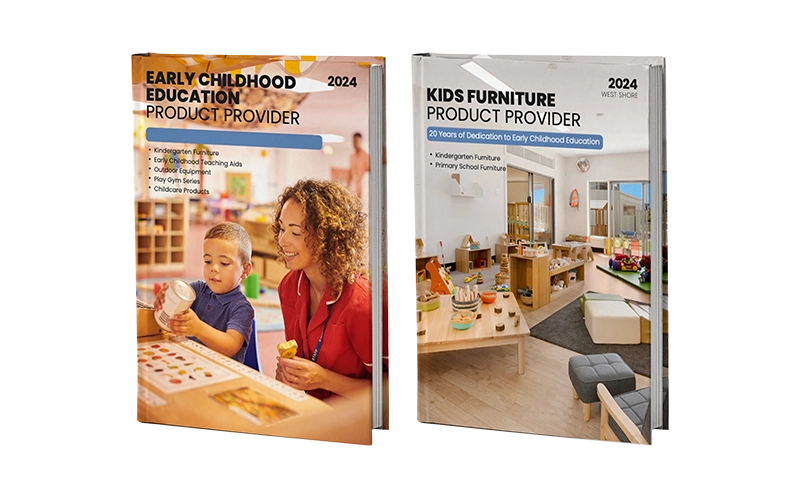
Ensuring Children’s Health and Safety
At the heart of sustainability is the well-being of the next generation. Sustainability efforts should always align with the core mission of any daycare: to provide a safe, healthy, and developmentally rich environment for children. Any sustainability initiative should also enhance, not compromise, health and safety.
Avoid Harmful Chemicals
Chemical exposure is one of the most preventable threats in early childhood settings. Many conventional materials used in furniture, flooring, and toys release toxins into the air, especially in enclosed spaces. Choosing certified materials ensures that products are free from harmful levels of chemicals.
Pay particular attention to soft materials such as cushions, mattresses, and rugs, which children come into close contact with. Educate families about your low-tox policies and explain the connection between product choice and child health.
Design Features That Support Learning
Sustainability should be experienced, not just explained. Install rain barrels and compost stations in outdoor areas. Build garden beds where children can plant herbs or vegetables. Introduce worm farms or bug hotels. These features are more than green; they are gateways into science, empathy, and ecological awareness.
Indoors, use materials that invite exploration: wooden puzzles, stones, baskets, wool ropes. When children interact with natural elements, they become more curious, focused, and grounded. These interactions also promote gross and fine motor skills, collaborative play, and respect for living things.
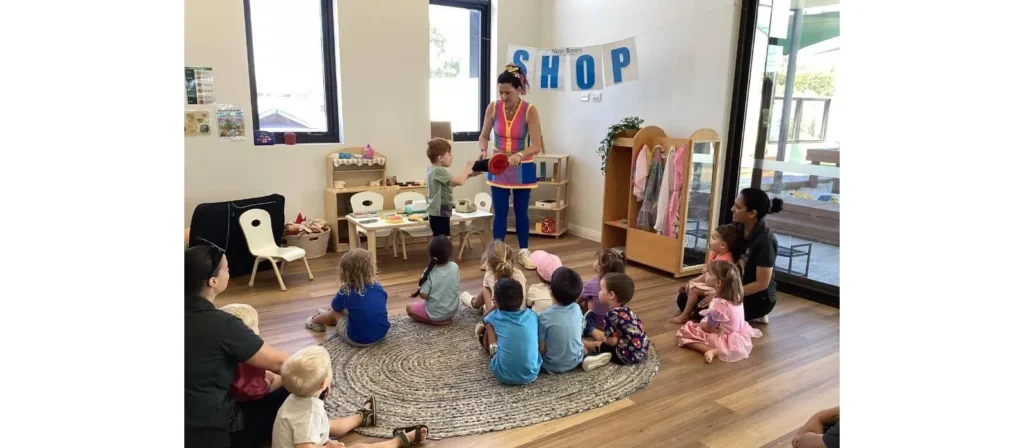
By integrating sustainability into your daycare center’s operations, materials, and environments, you are doing more than protecting the earth. You are investing in a healthier, richer, and more meaningful early learning experience. In the next section, we’ll explore how to bring these values directly to the children, teaching them eco-awareness in a way that’s age-appropriate, fun, and lasting.
How to Introduce Eco-Awareness to Children
Reading Eco-themed Books and Songs
One of the most effective Sustainable Practices in Childcare is weaving eco-awareness into literacy and music sessions. Instead of treating sustainability as a “special project,” educators can embed it in daily reading and circle time.
- Choose age-appropriate eco books: Titles like The Earth Book by Todd Parr or Compost Stew by Mary McKenna Siddals introduce concepts such as recycling, composting, and caring for the planet in playful language.
- Use repetitive eco songs: Songs such as “This Is the Way We Recycle” (to the tune of “Here We Go Round the Mulberry Bush”) help children remember actions like reusing paper or turning off taps.
When songs and stories are consistently linked to real classroom routines, children connect abstract eco concepts with practical behavior.
Discuss Sustainability at Home
Eco-awareness grows stronger when reinforced at home. Encouraging parents to talk about recycling, saving water, or choosing reusable containers allows children to see sustainability as part of daily family life, not just something practiced at daycare. Consistency across school and home builds lasting habits and shared values.
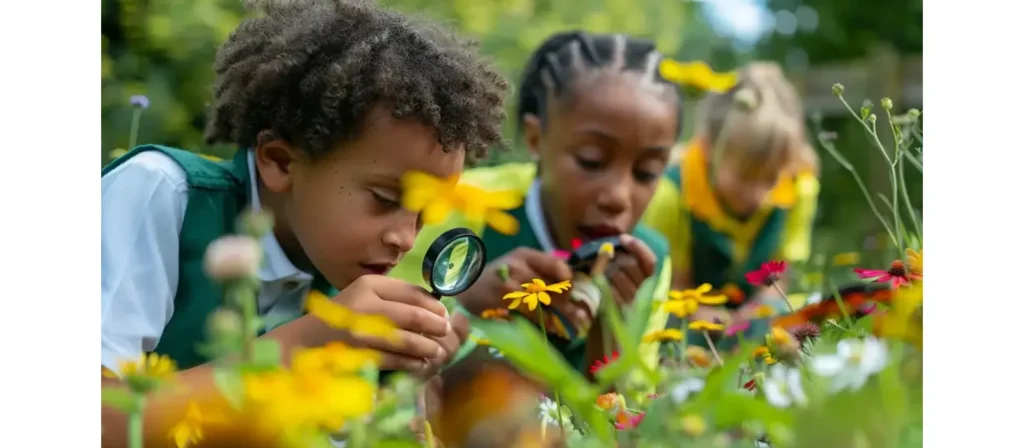
Encourage Outdoor Learning and Nature-based Play
Children learn sustainability best by interacting directly with nature. Outdoor environments make Sustainable Practices in Childcare visible and experiential.
- Insect exploration: Provide magnifying glasses and observation jars for children to study ants, butterflies, or beetles, then release them back safely.
- Scavenger hunts: Ask children to collect fallen leaves, pinecones, or flowers, and use them in art projects, showing how natural materials can be repurposed.
- Loose-parts nature play: Provide sticks, stones, and shells for construction and storytelling, encouraging creativity without relying on plastic toys.
- Eco-walks: Take children outside the center to notice litter, identify trees, or listen to birds, building direct respect for ecosystems.
Outdoor learning not only nurtures curiosity and problem-solving but also helps children understand their role in protecting the environment.
Vegetable Gardens or Composting
Hands-on projects are at the core of Sustainable Practices in Childcare. Gardening and composting show children the full cycle of growth, decay, and renewal in ways no book can.
- Vegetable patches: Assign each child a small section or a plant to care for. They water, weed, and harvest produce, then use it in cooking activities, linking gardening to nutrition.
- Mini herb gardens indoors: Use pots or recycled containers to grow mint, basil, or parsley on classroom windowsills. Children can snip leaves during snack preparation.
- Composting bins: Teach children to place food scraps into compost bins and observe the transformation into soil.
- Observation journals: Encourage older preschoolers to draw pictures of plant growth each week, helping them document change and reflect on res
These activities make sustainability concrete and enjoyable. When children watch a seed sprout into food or see compost transform into rich soil.
The Significance of Sustainability for Different Groups
For Children
Children are most receptive to new habits in their early years, making sustainability in childcare especially powerful. Simple routines such as recycling, watering plants, or reusing classroom materials show them that resources are valuable. These daily practices help children develop responsibility and empathy, shaping values that will stay with them throughout life.
For Educators
Educators carry the responsibility of modeling sustainable practices in childcare. By including eco-friendly routines in lesson plans and classroom activities, teachers demonstrate that sustainability is part of learning, not an extra subject. Using natural resources, encouraging nature play, and maintaining toxin-free environments also create healthier workplaces for staff while enriching the educational experience for children.
For Parents
Parents increasingly value eco-friendly daycare centers that reflect their own beliefs about health and responsibility. When a center uses safe materials, reduces waste, and communicates its childcare sustainability efforts, families gain confidence in the environment in which their children learn. Seeing children practice sustainable habits at home further strengthens the link between family and school.
Möchten Sie einen Raum gestalten, der zum Lernen anregt? Kontaktieren Sie uns, um individuelle Möbellösungen zu entwickeln, die auf die Bedürfnisse Ihres Klassenzimmers zugeschnitten sind.
Evaluation and Continuous Improvement
Conduct Regular Evaluations
Regular evaluations keep Sustainable Practices in Childcare measurable, compliant, and effective. Use a clear audit cycle with defined metrics, owners, and timelines so improvements are continuous rather than occasional.
Detailed evaluation process:
- Set goals and KPIs
Define what success looks like before you measure anything.
• Waste per child per week in kilograms
• Energy use per square meter in kWh per month
• Water use per child per day in liters
• Percentage of eco-certified or low-VOC materials in use
• Number of sustainability activities for childcare delivered per month
• Parent participation rate in green initiatives
• Incident rate related to materials or environment at zero - Form a Green Team and assign roles
Appoint a coordinator and nominate classroom champions and a facilities lead.
• Create a RACI map so each task has a Responsible, Accountable, Consulted, Informed person
• Schedule monthly check-ins of 20 minutes - Establish baseline and scope
• Gather the last 12 months of electricity, gas, and water bills
• Record current enrollment and average daily attendance
• Map bin locations, cleaning schedules, and procurement lists
• Note current learning experiences linked to sustainability in childcare - Run a one-week waste audit
• Label bins for landfill, recycling, and compost in each room
• Line audit bins and collect daily for five school days
• Weigh each stream and log kilograms per day and child
• Note the contamination rate for recycling and compost
• Identify top waste sources such as paper towels, food packaging, and nappies
• Photograph common errors to inform staff training
Outcome
• Target actions such as washable cloths, bulk snacks, reusable containers - Review energy use
• Record meter readings daily for one week, then weekly going forward
• Calculate kWh per square meter and compare rooms to find outliers
• Inventory lighting and replace remaining halogen or CFL with LED
• Test occupancy sensor performance and adjust delays
• Log equipment left on after hours and set shut-down checklists
• Confirm HVAC set points and maintenance dates
Outcome
• Create a room-level action list and a simple lights-out procedure - Review water use
• Read the water meter before and after hours to detect silent leaks
• Time flow rates at taps and showers, and fit aerators where needed
• Check dual flush toilets are working and labeled for children
• Review irrigation schedules and switch to early morning watering
• Inspect rainwater tanks and label use for garden only if applicable
Outcome
• Water reduction plan with liters per child targets - Materials and toxins safety check
• Inventory all cleaning agents, art supplies, adhesives, and finishes
• Verify low VOC or eco certifications and file Safety Data Sheets
• Remove products with synthetic fragrance, ammonia, or chlorine where feasible
• Spot check furniture for formaldehyde labels and prefer FSC wood
• Replace PVC-based mats with cork, linoleum, or rubber where practical
Outcome
• A low-tox purchasing list that supports a daycare with a healthy environment - Indoor air quality and ventilation check
• Use a portable CO2 monitor during peak occupancy to keep under 1000 ppm
• Check filter change dates and fit higher-grade filters where systems allow
• Open windows when outdoor conditions are safe
• Add hardy plants and set a care roster
Outcome
• IAQ log with monthly readings and corrective notes - Furniture and toys lifecycle review
• Inspect for damage and repair before replacing
• Prefer natural resources in childcare, such as wood, bamboo, cotton
• Record purchase dates and expected service life
Outcome
• Annual replacement plan that reduces waste and costs - Curriculum and routines audit
• Map weekly sustainability activities for childcare by age group
• Ensure child participation roles, such as light monitor and water monitor
• Link experiences to learning outcomes and document evidence
Outcome
• Program plan that embeds Sustainable Practices in Childcare into daily learning - Family and community feedback
• Issue a two-minute survey with three metrics
waste-free lunch participation, walking or cycling days, home recycling
• Set up a suggestion box and a quarterly parent workshop
Outcome
• Family engagement score and a list of joint projects - Vendor and procurement review
• Request supplier certifications for wood, finishes, and textiles
• Prefer bulk orders and minimal packaging
• Evaluate transport options that cut emissions and reduce damage risk
Outcome
• Approved supplier list aligned with childcare sustainability - Risk and compliance check
• Review garden, compost, and cleaning procedures for hygiene and safety
• Confirm alignment with local regulations and quality standards
Outcome
• Risk register with controls and training tasks - Prioritize actions using an impact and effort matrix
• Choose the top three high-impact low low-effort items to implement next month
• Assign owners and deadlines for each item - Implement, track, and report
• Create a one-page dashboard
waste per child, kWh per square meter, liters per child, IAQ readings, participation rates
• Post results on a staff board and a family board
• Celebrate wins and explain why they matter to children - Set a review calendar
• Waste audit monthly
• Energy and water review monthly
• Materials and indoor air quality quarterly
• Vendor review twice per year
• Full service review annually - Use simple templates
• Waste log with date, room, stream, kilograms, comments
• Energy and water tracker with meter reads and notes
• Materials checklist with product, certification, risk, and action
• Curriculum map with activity, outcome, evidence, frequency - Close the loop
Apply Plan Do Check Act across all Sustainable Practices in Childcare. Document what worked, adjust what did not, and repeat on schedule.
With this cycle, evaluations become a practical driver of improvement. Data informs decisions, children see progress in their environment, and the center strengthens its position as a leader in sustainability in childcare.
Collaborate with Experts
Implementing Sustainable Practices in Childcare is far more effective when supported by professional expertise. Partnering with sustainability consultants, local councils, or environmental NGOs provides access to knowledge, tools, and networks that an individual center may not develop on its own.
- Consultancy support: Specialists can conduct environmental audits, design waste management systems, and recommend low-toxic materials that meet child safety and sustainability requirements.
- Local council initiatives: Many councils offer free waste reduction programs, recycling bins, and grants for installing rainwater tanks or solar panels in early learning services.
- Partnerships with environmental organizations: NGOs can provide workshops for educators, child-friendly sustainability resources, and guidance on embedding eco-awareness into the curriculum.
- Supplier engagement: Working directly with manufacturers of early childhood furniture and resources ensures centers choose natural resources in childcare that are durable, safe, and compliant with sustainability certifications.
Benefits of collaboration:
- Aligns childcare sustainability efforts with national and international standards (such as Australia’s NQS or UN Sustainable Development Goals).
- Provides evidence-based recommendations rather than ad-hoc practices.
- Reduces risk by ensuring eco-materials and processes meet both health and regulatory requirements.
- Builds community credibility as families see the center taking expert-led action to safeguard both children and the environment.
By collaborating with experts, childcare centers move beyond symbolic gestures and build a robust framework of Sustainable Practices in Childcare that are practical, measurable, and future-ready.
Set Specific, Achievable Goals
Clear goals make sustainability efforts measurable and realistic. Instead of broad intentions, centers should set targets such as reducing electricity use by 10 percent, introducing composting within six months, or sourcing only non-toxic classroom furniture. Achievable goals create momentum and keep staff focused.
Celebrate Small Successes
Acknowledging progress, even small steps, keeps staff and children motivated. Celebrating achievements such as reducing paper waste or successfully maintaining a vegetable garden shows that sustainable practices in childcare produce tangible results. Recognition fosters pride and reinforces commitment to further improvement.
Communicate Sustainability Goals and Achievements
Sharing goals and progress with parents and the community strengthens childcare sustainability. Newsletters, bulletin boards, or family meetings can highlight ongoing projects and invite participation. Transparent communication builds trust and positions the center as a leader in sustainability.
Eco-friendly Classroom Design and Support Services
Designing an eco-friendly daycare classroom requires thoughtful choices that support both sustainability and child well-being. Using natural resources in childcare creates healthier learning spaces while reducing reliance on plastics. Flexible layouts with modular furniture minimize waste and adapt to diverse activities. Green cleaning and maintenance services further reinforce sustainable practices in childcare by reducing toxins and protecting daily health. At West Shore Möbel, we specialize in providing durable, eco-friendly daycare furniture and design support, helping centers worldwide align with sustainability goals and deliver classrooms that are safe, adaptable, and environmentally responsible.
